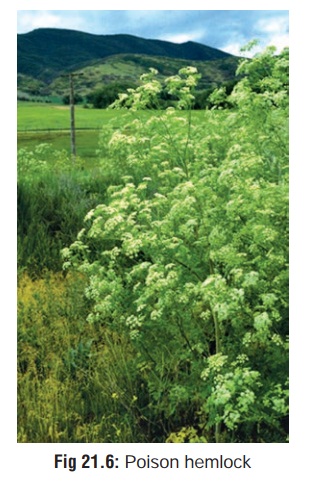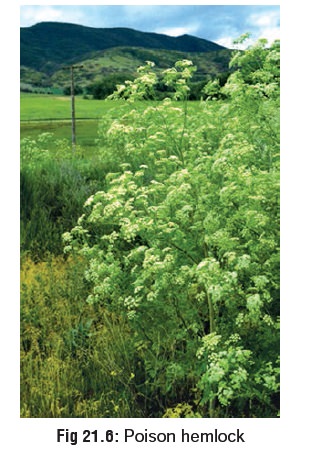Chapter: Modern Medical Toxicology: Neurotoxic Poisons: Spinal and Peripheral Neurotoxic Agents
Poison Hemlock - Spinal and Peripheral Neurotoxic Agents

POISON HEMLOCK
Botanical Name
Conium maculatum.
Physical Appearance
·
Hemlock belongs to the family
Umbelliferae of genus Cicuta, and is a biennial herb that grows erect to an
average height of 1 to 3 metres (Fig
21.6).
·
The larger stems are hollow and bear
numerous purple spots that are very distinctive.
·
Leaves are fine, light-green, and
fern-like. When crushed, they give off an unpleasant “mousy” smell.
·
Fruits are smooth skinned with
crenate ribs, and are binocu-lated, measuring about 9 mm long, and 6 mm across.

Toxic Part
All
parts.
Toxic Principles
The
toxins of poison hemlock are simple piperidine alkaloids: coniine and
gamma-coniceine. They are structurally similar to nicotine and possess similar
clinical features in toxicity.
Mode of Action
The
mode of action is two-fold. The most serious effect occurs at the neuromuscular
junction where these alkaloids act as non-depolarising blockers causing
respiratory failure due to flaccid paralysis. The second effect at the
auto-nomic ganglia is nicotinic in nature resulting in salivation, mydriasis,
and tachycardia, followed by bradycardia. Less commonly, rhabdomyolysis and
acute tubular necrosis can occur.
Clinical Features
·
Nausea, vomiting, abdominal pain.
·
Stimulant
phase: tachycardia, tremors, sweating, mydriasis,convulsions.
· Depressive phase: bradycardia, ascending motor paralysis,and coma.
![]()
Treatment
·
Aggressive
GI decontamination: lavage and activated charcoal.
·
Benzodiazepines for convulsions.
·
Respiratory support.
·
Forced diuresis may help in
preventing renal failure.
Forensic Issues
·
Hemlock was popular in ancient times
as a means of execu-tion. The most famous personality executed in this fashion
was Socrates, who was condemned to
death for his “crime” of introducing new divinities.
·
Today, most cases of hemlock
poisoning result from accidental circumstances due to mistaken identity with
edible vegetables such as wild carrot, parsley, or anise seeds.
Related Topics